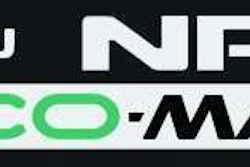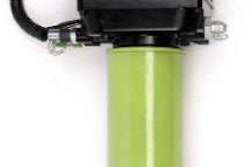The all-new 2011 Ford F-Series Super Duty delivers best-in-class torque, horsepower, towing and payload capability – and does it all more efficiently, resulting in less fuel usage and extended maintenance intervals that can translate directly into bottom-line savings for customers.
“The 2011 Super Duty is not only the most powerful, most capable and fuel-efficient heavy-duty pickup truck on the road, it performs the tough jobs with even more efficiency than ever before,” said Doug Scott, truck group marketing manager. “Customers can be confident that Super Duty’s class-leading capability comes with Ford’s ‘and solution’ of best-in-class fuel economy.”
All-new diesel and gas engine powertrains are the backbone of the 2011 Super Duty’s best-in-class towing (26,400 pounds for F-550 chassis cab with fifth-wheel hitch) and payload capability (6,520 pounds for F-350 dual rear-wheel pickup). The Ford-designed, Ford-engineered and Ford-built 6.7-liter PowerStroke V-8 turbocharged diesel engine produces best-in-class 735 ft.-lb. of torque at 1,600 rpm and best-in-class 390 horsepower at 2,800 rpm. The new engine is compatible up to B20 biodiesel fuel as well.
The new 6.2-liter V-8 gasoline engine also boasts best-in-class numbers of 405 ft.-lb. of torque at 4,500 rpm and 385 horsepower at 5,500 rpm. The new engine is E85 compatible.
Mated to each engine is the all-new 6R140 heavy-duty TorqShift six-speed automatic transmission. The added feature content and overall efficiency of the transmission are the main reasons for the improved fuel economy. The all-new 2011 Ford F-Series Super Duty equipped with the 6.7-liter PowerStroke diesel averages an 18 percent improvement for pickup models and up to 25 percent improvement for chassis cabs versus 2010 models. Trucks equipped with new base 6.2-liter V-8 gas engine average a 15 percent improvement versus 2010 models.
“The new transmission is a ‘clean-sheet’ design, developed specifically to handle the significantly increased torque produced by the new diesel engine and the higher rotational speeds produced by the new gas engine, and to deliver the power to the wheels seamlessly and efficiently for heavy-duty truck customers,” said Al Bruck, transmission engineering manager. “Each system and component was scrutinized to deliver optimum performance.”
Here’s a closer look at what was achieved and the benefits to the customer:
-
- New torque converter that locks at a far lower rpm than the competition:
The new, stronger torque converter is core to the improved transmission performance. One key component is the long-travel turbine damper that allows the transmission to lock earlier, at a lower rpm, which translates to less slip and more fuel efficiency. The new transmission locks down to 900 rpm, which is about 200 rpm less than the outgoing product and more than 100 rpm less than competitors. The second key component of the torque converter is the closed-piston design. This design allows for better control of the lock-up clutch, which enables controlled converter clutch slip during lock-to-lock upshifts that are seamless to the customer.-
– Customer fuel economy benefit: Locked converter operation at lower speeds means less wasted heat energy and better fuel economy.
-
- Optimized shift and converter lock-up schedule: After analyzing the entire shift schedule, Ford calibration engineers fine-tuned it by measuring and optimizing the fuel flow. The system recognizes light or heavy throttle use, and puts the transmission in the right gear for best performance and efficiency. The entire operating range has been optimized to get the best fuel economy by locking up the converter as soon as possible and as much as possible.
-
– Customer fuel economy benefit: Optimizing the shift schedule and lock schedule ensures customers automatically operate in the most efficient gears and save fuel.
-
- Gearing and double-overdrive: The 6R140 transmission has a ratio span of about 5.9, which is quite a bit wider than competitors. This wider span means the transmission has a deeper first gear that allows customers to get the load moving quicker, and a tall overdrive ratio for good highway efficiency. While the gearing itself is important, the key to overall efficiency is matching that gearing to the correct axle. With the diesel engine, up to four axle ratios are available on the pickups – 3.31, 3.55, 3.73 and 4.30. Matching up the gearing with the right axles means better overall efficiency.
-
– Customer fuel economy benefit: The double-overdrive gear means even if a customer gets a downshift on the highway, the transmission remains in overdrive. Also, the F-450 pickup went from a 4.88 axle to a 4.30 axle at launch for the 2011 model mated to the wide ratio span of the transmission. This and other optimizations mean the F-450 now has about a 30 percent improvement in fuel economy.
-
- Optimized pumping pressure: A certain amount of pressure is required to hold the clutches together so they don’t slip. The trick is to have the right amount of pressure to do the job. Too much pressure wastes fuel. The solution is to optimize the size of the pump and precisely control the pressure for all operating conditions.
-
– Customer fuel economy benefit: At highway speeds, for example, the line pressure is reduced, which helps save fuel. The system maintains the right amount of pressure for any given speed range. The less energy needed for internal pump pressure means less fuel used.
-
- Optimized drainback to reduce spin losses: A main objective is to get the fluid through the main barrel to lubricate and cool components, and get it back to the sump as quickly as possible. This reduces windage and parasitic loss. The clutch friction plates were designed to allow fluid to flow through them efficiently for cooling and reduced drag. Clutch housings, connecting shells and the main case housing were optimized to quickly drain the fluid out of rotating components and back into the sump.
-
– Customer fuel economy benefit: Fewer parasitic losses due to reduced churning of fluid increases fuel economy.
-
- Warmer operating temperature: Tied in with spin losses, the 6R140 cooling system has been optimized to allow for the proper amount of cooling when towing heavy loads in high ambient temperatures, while running at an overall higher stabilized temperature. This higher stabilized temperature lowers the viscosity and helps the fluid flow more easily, which reduces parasitic losses and saves fuel. The fluid also warms up faster because it does not flow to the cooling circuit until properly warmed up. Faster warm-up also reduces overall parasitic losses.
-
– Customer fuel economy benefit: Fewer parasitic losses due to reduced fluid viscosity translates to less internal drag on the system and increases fuel economy.
-
- New torque converter that locks at a far lower rpm than the competition:
Lighter, more efficient than competition
The 6R140 transmission is about 25 pounds lighter than those of competitors. The new engines are lighter than the outgoing products as well, which altogether means much more efficient power flow on a pound-for-pound basis. The 6R140 also has a 150,000-mile fluid change interval, which is 2½ times greater than the outgoing product. A patent-pending high-efficiency dual-media filter is the main reason for the extended maintenance interval, which is another savings for customers.
Cleanest PowerStroke ever
The new 6.7-liter PowerStroke V-8 turbocharged diesel employs an aftertreatment system to help comply with 2010 federal regulations to reduce NOx levels in diesel emissions by more than 80 percent compared with the previous standard. The Ford aftertreatment system is a three-stage process; a key component is the use of Diesel Exhaust Fluid (DEF).
Injection of DEF to reduce NOx is a proven technology that’s been used throughout the automotive industry. Unlike other strategies used to control NOx, the DEF system allows the diesel engine to run at its optimum range in terms of fuel mixture. Some systems require the engine to run richer – which can be harmful to diesel engines – in order to control the NOx.
The aftertreatment system works like this:
-
Step One: Cleaning and Heating – The first step in cleaning the diesel exhaust occurs when the exhaust stream enters the Diesel Oxidation Catalyst (DOC). The role of the DOC is twofold. First, it converts and oxidizes hydrocarbons into water and carbon dioxide. This conversion happens at about 250 degrees Celsius.
Second, the DOC is used to provide and promote heat, using specific engine management strategies, into the exhaust system. Through appropriate thermal management, this heat increases the conversion efficiency of the downstream subsystems in reducing emissions.
Step Two: Knocking Out the NOx – The next step in the process is what’s known as Selective Catalytic Reduction (SCR). In this process, the NOx in the exhaust stream is converted into water and inert nitrogen, which is present in the atmosphere and harmless. Before the exhaust gas enters the SCR chamber, it is dosed with DEF, an aqueous solution that is approximately 67.5 percent water and 32.5 percent pure urea.
When heated, the DEF splits into ammonia and carbon dioxide. These molecules are atomized and vaporized, then enter a mixer that resembles a corkscrew. This twist mixer evenly distributes the ammonia within the exhaust flow. The ammonia enters the SCR module, which contains a catalyzed substrate, and through chemical reactions combines and converts the NOx and ammonia into the harmless inert nitrogen and water. Dosing occurs between 200 and 500 degrees Celsius.
Step Three: Scrubbing Away the Soot – The final part of the cleansing system for the diesel exhaust gas involves the Diesel Particulate Filter (DPF). The DPF traps any remaining soot, which is then periodically burned away, known as regenerating, when sensors detect the trap is full. The regeneration process sees temperatures in excess of 600 degrees Celsius to burn away soot.
This industry-proven technology ensures that the new 6.7-liter diesel is the cleanest PowerStroke ever, as well as the most fuel-efficient.
“Having this diesel designed in-house at Ford meant we were able to work on optimizations and refinements right from the start,” said Tim Ogilvie, vehicle energy supervisor. “We’re able to deliver to customers a more refined, more fuel-efficient Super Duty, with class-leading torque and horsepower and the class-leading capability they demand.”











